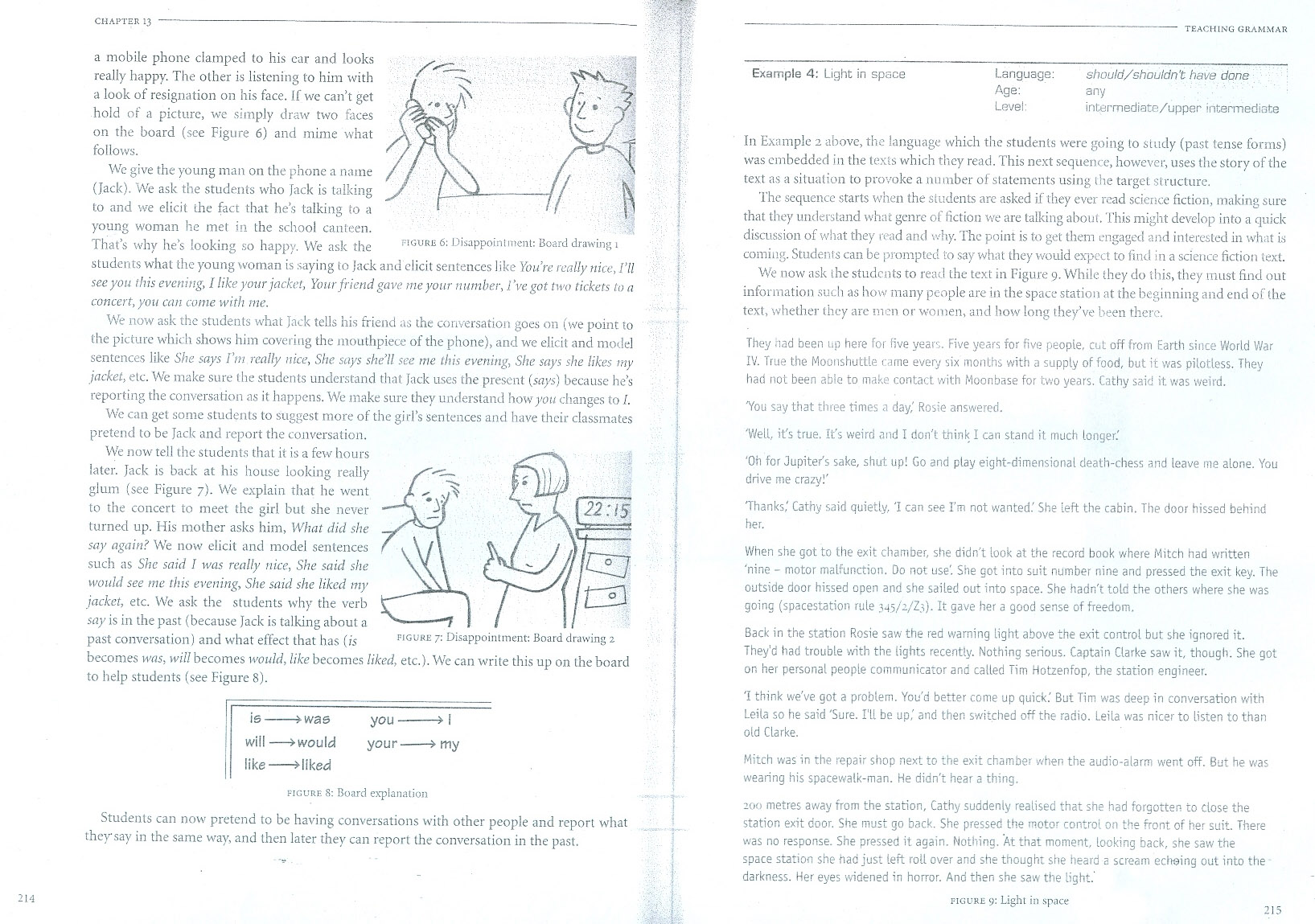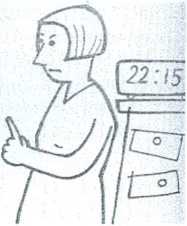0013

CH APTEK !3
CH APTEK !3

figurę 6: Disappoinlment: Board drawing i
a mobile phone clamped to his car and looks really happy. The other is listcning to him with a look of resignation on his face. If we can’t get hołd of a picture, we simply draw two faces on the board (see Figurę 6) and minie what follows.
We give the young man on the phone a naine (Jack). We ask the students who Jack is talking to and we elicit ihe fact that he’s talking to a young woman he met in the school canteen.
That’s why he’s looking so happy. We ask the students what the young woman is saying to Jack and elicit sentences like Youre really nice, I’ll seeyou this evening, I like your jacket, Your friend gave meyoiir mtmber, Pve got two tickets to a concert, you can eonie with me.
We now ask the students what Jack tells his friend as the conversation goes on (we point to the picture which shows him covering the mouthpiece of the phone), and we elicit and model sentences like She says Pm really nice, She says she’ll see me this evening, She says she likes my jacket, etc. We make surę the students understand that Jack uses the present (says) because he’s reporting the conversation as it happens. We make surę they understand how you changes to I.
We can get sonie students to suggest morę of the girFs sentences and have their classmates pretend to be Jack and report the conversation.

figurę 7: Disappointment: Board drawing 2
We now tell the students that it is a few hours la ter. Jack is back at his house looking really glum (see Figurę 7). We explain that he went to the concert to meet the girl but she never turned up. His mother asks him, What did she say again? We now elicit and model sentences such as She said ! was really nice, She said she would see me this evening, She said she liked my jacket, etc. We ask the students why the verb say is in the past (because Jack is talking about a past conversation) and what effect that has (is becomes was, will becomes would, like becomes liked, etc.). We can write this up on the board to help students (see Figurę 8).
is-»was you-->1
will—»would your-> my
like-Hiked
figurę 8: Board explanałion
Students can now pretend to be having comersations with other people and report what they say in the same way, and then later they can report the conversation in the past.
Example 4: Light in space Language: should/shouldnt have dane
Age: any
Leuel: intermediate/upper intermediote
In Example 2 above, the language which the students were going to Siudy (past tense forms) was cmbedded in the texts which they read. This next sequence, however, uses the story of the text as a situation to provoke a number of statements using the target structure.
The seąuence starts when the students are asked if they ever read science fiction, making surę that they understand what genre of fiction we are talking about. This might develop into a quick discussion of what they read and why. The point is to get thern engaged and interested in what is coming. Students can be prompted to say what they would expect to find in a science fiction text.
We now ask ihe students to read the text in Figurę 9. While they do this, they rnust find out information sucli as how many people are in the space station at the beginning and end of the text, whether they are men or women, and how long they’ve been therc.
They had been up here for five years. Five years for five peopte. cut off from Earth sińce World War IV. True the Moonshuttle came every six months with a supply of food, but it was pilotless. They had not been abie to make contact with Moonbase for two years. Cathy said it was weird.
You say that three times a day,' Rosie answered.
'Weil, it's true. It’s weird and I doift think I can stand it much longer.'
‘Oh for Jupitefs sake, shut up! Go and play eight-dimensional death-chess and leave me alone. You drive me crazv!'
Thanks,' Cathy said quietly, 'I can see I'm not wanted.' She teft the cabin. The door hissed behind her.
When she got to the exit chamber, she didr/t look at the record book where Mitch had written 'nine - motor malfunction. Do not use'. She got into suit number nine and pressed the exit key. The outside door hissed open and she sailed out into space. She hadn't told the others where she was going (spacestation rule 345/2/Z3). It gave her 3 good sense of freedom.
Back in the station Rosie saw the red warning light above the exit contro! but she ignored it.
They’d had trouble with the (ights recently. Nothing serious. Captain Ciarkę saw it, though. She got on her personal people communicator and called Tim Hotzenfop, the station engineer.
T think we've got a problem. Youd better come up quick.' But Tim was deep in conversation with Leila so he said 'Surę. Tli be up,' and then switched off the radio. Leila was nicer to listen to than old Ciarkę.
Mitch was in the repair shop next to the exit chamber when the audio-alarm went off. But he was wearing his spacewalk-man. He didn't hear a thing.
200 metres away from the station, Cathy suddeniy realised that she had forgotten to close the station exit door. She must go back. She pressed the motor control on the front of her suit. There was no response. She pressed it again. Nothing. At that moment, looking back, she saw the space station she had just teft roli over and she thought she heard a scream echoing out into the darkness. Her eyes widened in horror. And then she saw the light.
figurę 9: Light in space
Wyszukiwarka